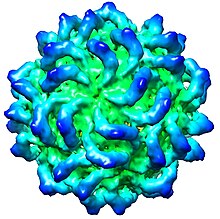Partitiviridae
| Partitiviridae | |
|---|---|

| |
| CryoEM reconstruction of Penicillium stoloniferum virus S capsid, a partitivirus. EMDB entry EMD-5161[1] | |
| Virus classification | |
| Group: | Group III (dsRNA)
|
| Order: | Unassigned
|
| Family: | Partitiviridae
|
| Genera | |
Partitiviridae is a family of viruses. Fungi and plants serve as natural hosts. There are currently 56 species in this family, divided among 5 genera.[2][3] Their name comes from the Latin partitius which means divided and they are called this as they have segmented genomes.
Genome and structure
Viruses in Partitiviridae are non-enveloped, with icosahedral geometries, and T=1 symmetry. The diameter is around 35-40 nm. Partitiviruses have double stranded RNA genomes divided into two genomic segments and there may be additional subgenomic segments. The genome segments are packaged in the same virus particle, the larger segment codes for the RNA-dependent RNA polymerase and the smaller codes for the coat protein. Genomes are linear and around 1.4-3.0kb in length. The genome codes for 2 proteins.[2]
| Genus | Structure | Symmetry | Capsid | Genomic Arrangement | Genomic Segmentation |
|---|---|---|---|---|---|
| Cryspovirus | Icosahedral | T=1 | Non-Enveloped | Linear | Segmented |
| Alphapartitivirus | Icosahedral | T=1 | Non-Enveloped | Linear | Segmented |
| Deltapartitivirus | Icosahedral | T=1 | Non-Enveloped | Linear | Segmented |
| Betapartitivirus | Icosahedral | T=1 | Non-Enveloped | Linear | Segmented |
| Gammapartitivirus | Icosahedral | T=1 | Non-Enveloped | Linear | Segmented |
Life Cycle
Viral replication is cytoplasmic. Entry into the host cell is achieved by penetration into the host cell. Replication follows the double-stranded RNA virus replication model. Double-stranded RNA virus transcription is the method of transcription. The virus exits the host cell by cell-to-cell movement. Fungi and plants serve as the natural host.[2]
| Genus | Host Details | Tissue Tropism | Entry Details | Release Details | Replication Site | Assembly Site | Transmission |
|---|---|---|---|---|---|---|---|
| Cryspovirus | Protists | None | Cell division; sporogenesis; hyphal anastomosis | Cell division; sporogenesis; hyphal anastomosis | Cytoplasm | Cytoplasm | Cell division; sporogenesis; hyphal anastomosis |
| Alphapartitivirus | None | Cytoplasm | Cytoplasm | Cell division | |||
| Deltapartitivirus | Plants | None | Viral movement; mechanical inoculation | Cell division | Cytoplasm | Cytoplasm | Cell division |
| Betapartitivirus | None | Cytoplasm | Cytoplasm | Cell division | |||
| Gammapartitivirus | Fungi | None | Cytoplasmic exchange; hyphal anastomosis | Cytoplasmic exchange; hyphal anastomosis | Cytoplasm | Cytoplasm | Cytoplasmic exchange; hyphal anastomosis |
Taxonomy
There are currently five recognized genera within the Partitiviridae family:
Group: dsRNA
- Family: Partitiviridae
- Genus: Alphapartitivirus
- Beet cryptic virus 1
- Carrot cryptic virus
- Cherry chlorotic rusty spot associated partitivirus
- Chondrostereum purpureum cryptic virus 1
- Flammulina velutipes browning virus
- Helicobasidium mompa partitivirus V70
- Heterobasidion partitivirus 1
- Heterobasidion partitivirus 3
- Rosellinia necatrix partitivirus 2
- Vicia cryptic virus
- White clover cryptic virus 1
- Genus: Betapartitivirus
- Atkinsonella hypoxylon virus
- Cannabis cryptic virus
- Ceratocystis resinifera virus 1
- Crimson clover cryptic virus 2
- Dill cryptic virus 2
- Fusarium poae virus 1
- Heterobasidion partitivirus 2
- Heterobasidion partitivirus 8
- Heterobasidion partitivirus P
- Hop trefoil cryptic virus 2
- Pleurotus ostreatus virus 1
- Primula malacoides virus 1
- Red clover cryptic virus 2
- Rhizoctonia solani virus 717
- Rosellinia necatrix virus 1
- White clover cryptic virus 2
- Genus: Unassigned
- Agaricus bisporus virus 4
- Alfalfa cryptic virus 1
- Carnation cryptic virus 1
- Carrot temperate virus 1
- Carrot temperate virus 2
- Carrot temperate virus 3
- Carrot temperate virus 4
- Gaeumannomyces graminis virus 019/6-A
- Gaeumannomyces graminis virus T1-A
- Hop trefoil cryptic virus 1
- Hop trefoil cryptic virus 3
- Radish yellow edge virus
- Ryegrass cryptic virus
- Spinach temperate virus
- White clover cryptic virus 3
Cryspoviruses infect apicomplexian protozoa of the genus Cryptosporidium,[4] while viruses of the other genera infect plants and fungi. There are an additional fifteen species in the family unassigned to a genus.
Phylogenetics
Based on the RNA polymerase gene this group can be divided into four clades (I-IV).[5] Four isolates from animals and protozoans form a fifth clade. Clades I-IV consist of mixtures of partitivirus-like sequences from plants and fungi.
References
- ^ Tang, J.; Pan, J.; Havens, W. M.; Ochoa, W. F.; Guu, T. S. Y.; Ghabrial, S. A.; Nibert, M. L.; Tao, Y. J.; Baker, T. S. (2010). "Backbone Trace of Partitivirus Capsid Protein from Electron Cryomicroscopy and Homology Modeling". Biophysical Journal. 99 (2): 685–694. doi:10.1016/j.bpj.2010.04.058. PMC 2905076. PMID 20643089.
- ^ a b c "Viral Zone". ExPASy. Retrieved 15 June 2015.
- ^ a b ICTV. "Virus Taxonomy: 2014 Release". Retrieved 15 June 2015.
- ^ Nibert ML, Woods KM, Upton SJ, Ghabrial SA (2009) Cryspovirus: a new genus of protozoan viruses in the family Partitiviridae. Arch Virol 154(12):1959-1965
- ^ Liu H, Fu Y, Xie J, Cheng J, Ghabrial SA, Li G, Yi X, Jiang D (2012) Discovery of Novel dsRNA Viral Sequences by In Silico Cloning and Implications for Viral Diversity, Host Range and Evolution. PLoS One. 2012;7(7):e42147.
